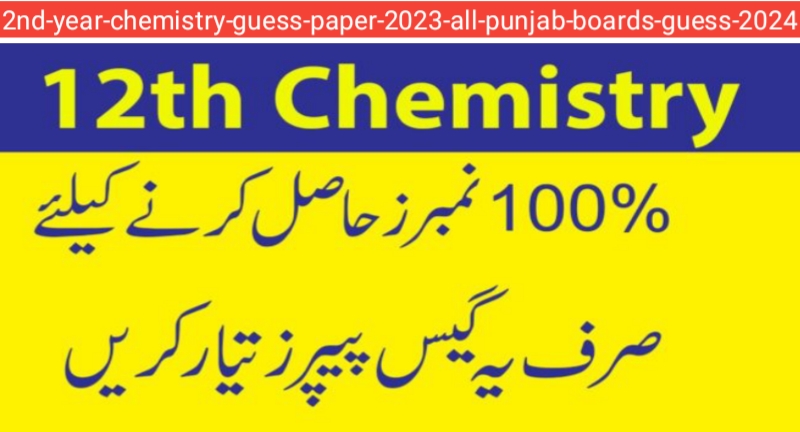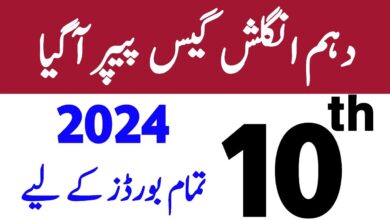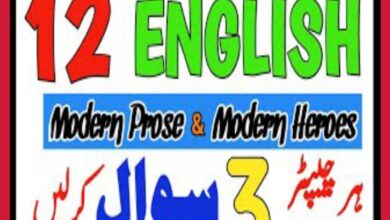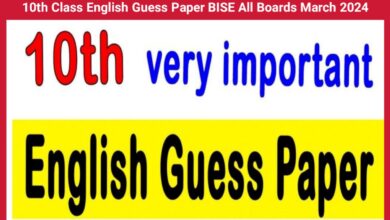2nd Year Chemistry Guess Paper 2023 All Punjab Boards guess | 2024


2nd Year Chemistry Guess Paper 2023 All Punjab Boards guess | 2024
Second year Guess paper all subjects
Table Of Contents
In chemistry we study chemicals, their uses and their properties. Chemistry is the most interesting subject. Chemistry is not only an important science subject but also has great importance in our practical life. Students can get 100% marks estimate sheet in pdf format from here. 12th class chemistry guess paper 2023.
For second year students, Class 12 Chemistry estimate paper is available here for the students.
Your chemistry exam becomes more easily if you practice chemistry guess paper 2023. In Chemistry Guess Paper, experienced teachers share their guess and experience that what type of short questions and long questions will be asked in the exam. These Chemistry 2nd Years Guess Paper 2023 are very important Important Guess Papers are given below. Many questions will be like this in the board exam.
second year chemistry estimate paper
2nd Year Chemistry Estimate Paper 2023
12th class chemistry guess paper 2023
chemistry guess paper 2023 12th class
12th class chemistry guess paper 2023
2nd year chemistry guess paper – Important Questions chapterwise

Below is the detailed guess paper pf chemistry class 12 which include all chapter important quesions 2023
Chapter 1
Important short questions
- Why metals are good conductors?
- Define hydration energy with examples.
- Diamond is a non-conductor but graphite is good conductor. Why?
- Ionization energy increases from left to right in a period. Justify.
- How does hydrogen resemble with group IV-A elements.
- Why oxidation number of noble gases is usually zero?
- What is electron affinity? Give its trend in periodic table.
- Justify the position of hydrogen at the top of group VII-A elements.
- Give reasons that hydration energy of Al3+ ions more than Mg2+ ion?
- Give differences of lithium from its own family members.
- Why the size of an anion is always greater than its parent atom?
- Name various classes of hydrides.
- Why metallic character increases from top to bottom in a group of metals?
- Alkali metals give ionic hydrides. Why?
- Give four uses of nitric acid.
Important long questions
- Give trends of metallic character in groups and periods and discuss the impact of atomic size on it.
- Explain the term periodic table and discuss the improvements made in Mendeleeve’s periodic table.
- What are hydrides? Discuss their classification and properties.
Chapter 2
Important short questions
- How does hydrogen resemble with alkali metals?
- Write formula of borax and Chile saltpetre.
- Give formula of natron and halite.
- How will you distinguish between ethanol and propanol.
- Give two similar properties of lithium and magnesium.
- Write chemical formula of Beryl and Barite.
- What are two major problems faced during the working of diaphragm cell?
- Why Down’s cell is preferable method for the preparation of sodium on large scale?
- Give formula of (i). Dolomite (ii.) Asbestos
- What reaction occur when (i). Lithium carbonate is heated (ii). Sodium bicarbonate is heated
Important long questions
- Discuss the preparation of sodium hydroxide on commercial scale by diaphragm cell or Nelson’s cell.
- Describe the process of sodium metal manufacturing by Down’s cell.
- Complete and balance the following equations
i. Li2O + H2O ii. Na2O + H2O iii. Mg + (OH)2 iv. NaNO3
Chapter 3
Important short questions
- Write four uses of Borax.
- What is borax bread test?
- How is Borax used an water softening agent?
- Why are borate glazes preferred over silicate glazes?
- Give any four uses of aluminium in our daily life.
- Give two similarities between carbon and silicate.
- Give reaction of P2O5 with cold and hot water
- The aqueous solution of borax is alkaline. Give reason.
- What is carbonization?
- Explain the structure of CO2.
- Write two uses of sodium silicate. (2)
- How borax can be prepared from colemanite? Give equation
- Write names and formulas of oxyacids of nitrogen.
Important long questions
- Write a note on aluminum silicate.
- Write a method for preparation of water glass. Also, write uses of water glass.
- How will you convert boric acid into borax and vice versa.
Chapter 6
Important short questions
- All exercise short questions.
Important long questions
- Write a note : i) Binding energy ii) Paramagnetism.
- Explain the following properties for transition element. I) Paramagnetic ii) Colour
Chapter 7
Important Short Questions
- What is meant by organic chemistry?
- What are homocyclic and heterocyclic compounds? Give examples.
- Why is ethene an important industrial element?
- Define isomers. Write the names of its four types.
- What is meant by a functional group? Name typical functional groups containing oxygen.
- Define thermal cracking and steam cracking.
- What is meant by catenation? Give examples.
- What is meant by cis-trans isomerism?
- Define tautomerism and give example.
- Define alicyclic and aromatic compounds.
- What is petroleum? Give its origin.
- Why is ethene an important industrial chemical?
- What is coal tar? Give its fractions.
- How will you define octane number? How it can be improved?
- What is iodized salt?
- Write the structural formula of two possible isomers of C4H10.
- Describe important sources of organic compounds.
- What is catalytic cracking?
Important long questions
- What is orbital hybridization? Explain , , and mode of hybridization
- Describe the important sources of organic compounds.
- Define Isomerism. Explain its types.
- 2. Write down the process of cracking of petroleum.
Chapter 8
Important short questions
- How do you distinguish between ethane and ethyne?.
- Why the π bond is more reactive than ϭ bond?
- Convert 1-butene to 1-butyne.
- Give fours uses of methane.
- Synthesize i.benzene ii. Oxalic acid from ethyne.
- Convert ethene into ethylalcohol?
- What is Markonikov’s rule?
- Write a note on acidity of ethene?
- Convert methane into formic acid.
- What is Raney-Nickel? Give its uses.
- Alkanes are less reactive than alkenes. Comment.
- Convert ethyne into acetaldehyde.
- How cis and trans alkenes are produced? Give reactions.
- Convert ethene into ethylalcohol?
- What is hydrogenolysis?
- What is Baeyer’s Test? Give its uses
Important Long questions
- Describe with examples the acidic nature of alkynes?
- Give comparison of reactivity of alkanes, alkenes and alkynes.
- Prepare Ethane from Kolbe’s Electrolytic method. Write down it mechanism.
- Give the chemical reactions of ethene with:
(i) O2 in the presence of Ag2O (ii) Conc. H2SO4 (iii) S2Cl2 (iv) HOCl.
Chapter 9
Important short questions
- Briefly describe x-ray studies of benzene structure.
- Define electrophile. Give two examples.
- Give reaction of benzene with ozone.(ozonolysis)
- How benzene is converted into maleic acid by catalytic oxidation?
- What are aromatic compounds?
- Why benzene is less reactive than alkene?
- What is Wurts Fitting reaction? Give its importance.
- Give two oxidation reactions of benzene.
- What are fused rings aromatic compounds?
- Give reaction of benzene with SO3.
- Prepare benzene from i. n-Hexane ii. Sodium benzoate
- Give the mechanism of nitration of Benzene.
- Give reactivity of benzene towards electrophiles.
- Show Benzene’s cyclic structure with diagram.
- Define aromatization.
Important long questions
- Convert Benzene into:
i) Cyclohexane ii) Maleic acid iii) Glyoxal iv) Benzene sulphonic acid
- What are Friedel-Crafts reactions? Explain mechanism of alkylation and acylation of benzene
- Write any four chemical methods for the preparation of benzene.
- Give reactions of benzene with respect to (i) nitration (ii) sulphonation
Chapter 10
Important Short Questions
- Prepare (i) ethyl bio alcohol (ii) ethyl acetate from ethyl bromide.
- What are primary, secondary and tertiary alkyl halides? Give example of each.
- Explain Markownikov’s rule with suitable example.
- Starting from C2H4Br how will you prepare ethane and ethene?
- Explain the following reaction: CH4 CH3CH2COOH.
- How do you compare SN1 and SN2 mechanism?
- How do we get alkyl nitriles from Grignard’s reagent?
https://chat.whatsapp.com/J6w7sHWRHiaAO71N1DqJ2i - What are elimination reactions? Give an example of E1 reaction.
- What is Grignard reagent?
- What are Alkyl halides? Give their general formula.
- What are types of nucleophilic substitution reaction?
- Convert ethyl alcohol into their respective halides by using PCl3 and PI5
- What is Wurtz synthesis?
- What is Grignard reagent?
Important Long Questions
- Describe SN2 reaction of alkyl halides with details.
- Explain the mechanism of nucleophilic substitution reaction.
- Describe β elimination reaction E2 with example.
- How the presence of double bond can be detected by using Baeyre’s reagent?
Chapter 11
Important short questions
- Convert methanol into ethanol
- Differentiate between primary and secondary alcohols.
- Write structural formula of a)carbolic acid b)glycerol
- What are rectified spirit, commercial alcohol and absolute alcohol?
- Why water has higher boiling point than ethanol?
- Convert methanol into ethanol and acetone into ethyle alcohol.
- What is Lucas test?
- Give the uses of ethyle alcohols and methyl alcohols.
- Ethyl alcohol is liquid while methyl chloride is a gas. Why?
- Write the names and formulas of two polyhydric alcohols.
- Define fermentation. Give its conditions.
- Absolute alcohols cannot be prepared by fermentation. Why?
- What is wood-spirit? How is it prepared from water gas?
- Write equation for the reaction of C2H5OH with PBr3, PCI5
Important Long Questions
- How alcohols are prepared? Give their properties and uses.
- What is either? Give its reactions.
- Explain the following properties with reference to phenol: i) Esterification ii)sulphonation
Chapter 12
Skip this chapter
Chapter 13
Important Short questions
- What are peptides and peptide linkage?
- What is ninhydrin test?
- What are aromatic carboxylic acids?
- Give the mechanism for the esterification of the carboxylic acids.
- What are essential and non-essential amino acids?
- Name five dicarboxylic acids and give their formulas.
- What is strecker’s synthesis?
- Give four uses of nitric acid.
- How carboxylic acid is converted into a-amino acids?
- Give four uses of acetic acid.
- How ethanol is converted into acetic acid and vice versa?
- Define proteins? How do they differ from polypeptides?
- What are fatty acids? Give examples.
- What are Zwitter ions? Give equation.
- How will you prepare acetic acid from ethynes?
Chapter 14
- Define carbohydrates. Classify them and give example of each.
- What do you mean by rancidity of fats and oils?
- Define the following: i. proteins ii. Lipids iii. polymers
- How is polystyrene prepared? Give its two uses.
- Give the structure of cholesterol.
- Write down uses of proteins.
- What is saponification number and iodine number?
- What are fatty acids? Give examples.
- How polymers are classified on the basis of heat effect?
Chapter 15+16
- What reaction takes place in decomposition zone during manufacturing of cement?
- Which type of woody raw material is used in paper industry?
- Write two woody and two non woody raw material for paper pulp manufacture.
- What are macro nutrients?
- What is role of chlorofluorocarbons in destroying ozone?
- How do you compare SN1 and SN2 mechanism?
- What is need for fertilizers?
- What do you mean by prilling of urea?
- What are some commonly used bleaching agents in paper manufacture?
- Define clinker? How is it used in manufacturing of Cement.
- What is meant by setting of cement?
- What is the role of phosphorus in growth of plants?
- Give the role/importance of potassium in the growth of plants.
- Write names of steps in paper making process
2nd Year Chemistry Guess Paper 2023 Punjab Board guess. Click On Download Button 👇👇👇
Join Us On :
Click Here To Get All Latest Government Jobs And Education News : https://mediaandjobs.com/
What’s app Group 1 (Jobsgoro And Updates)
https://chat.whatsapp.com/CVwROiD9kKSFwq6pnIdQxi
Click Here To Join Our Facebook Page To Get All Latest Government Jobs And Education News : https://www.facebook.com/profile.php?id=100085051735597&mibextid=ZbWKwL



